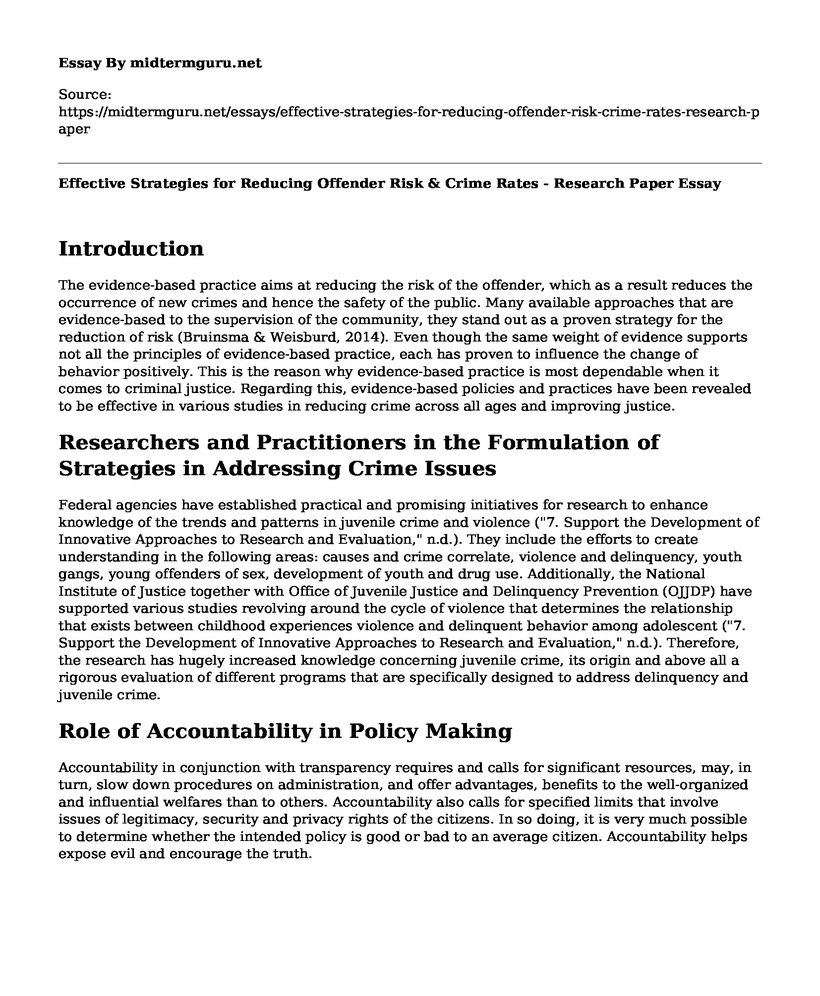Introduction
The evidence-based practice aims at reducing the risk of the offender, which as a result reduces the occurrence of new crimes and hence the safety of the public. Many available approaches that are evidence-based to the supervision of the community, they stand out as a proven strategy for the reduction of risk (Bruinsma & Weisburd, 2014). Even though the same weight of evidence supports not all the principles of evidence-based practice, each has proven to influence the change of behavior positively. This is the reason why evidence-based practice is most dependable when it comes to criminal justice. Regarding this, evidence-based policies and practices have been revealed to be effective in various studies in reducing crime across all ages and improving justice.
Researchers and Practitioners in the Formulation of Strategies in Addressing Crime Issues
Federal agencies have established practical and promising initiatives for research to enhance knowledge of the trends and patterns in juvenile crime and violence ("7. Support the Development of Innovative Approaches to Research and Evaluation," n.d.). They include the efforts to create understanding in the following areas: causes and crime correlate, violence and delinquency, youth gangs, young offenders of sex, development of youth and drug use. Additionally, the National Institute of Justice together with Office of Juvenile Justice and Delinquency Prevention (OJJDP) have supported various studies revolving around the cycle of violence that determines the relationship that exists between childhood experiences violence and delinquent behavior among adolescent ("7. Support the Development of Innovative Approaches to Research and Evaluation," n.d.). Therefore, the research has hugely increased knowledge concerning juvenile crime, its origin and above all a rigorous evaluation of different programs that are specifically designed to address delinquency and juvenile crime.
Role of Accountability in Policy Making
Accountability in conjunction with transparency requires and calls for significant resources, may, in turn, slow down procedures on administration, and offer advantages, benefits to the well-organized and influential welfares than to others. Accountability also calls for specified limits that involve issues of legitimacy, security and privacy rights of the citizens. In so doing, it is very much possible to determine whether the intended policy is good or bad to an average citizen. Accountability helps expose evil and encourage the truth.
How Policymakers Evaluate Policy
The policymakers first study the policy's legislative history they are evaluating. It is essential to understand how the policy came into existence to its incumbent state. They then identify the crucial policy's stakeholders. The following step is describing the policy under evaluation in full (including an outline of the policy, its associated goals, and purposes). It is then followed by collecting the information required for evaluation (the info may be qualitative or quantitative or a combination of the two), analyze the data and then finally report the conclusions regarding the analysis ("7. Support the Development of Innovative Approaches to Research and Evaluation," n.d.). It usually includes recommendations for the policy changes or the enhancements that need to be added or put in place.
Difference Between Evaluation and Assessment
According to Bruinsma and Weisburd (2014), assessment is a process of collecting, carrying out a review and utilization of data for improvement in the current ongoing performance. On the other hand, evaluation is an act of passing a conclusion or a judgment by a set of given standards, or still, it can be described as a process of observing and measuring a thing to judge it by comparing it to a given rule. One may regard to assessment and evaluation as the same; they are different terms with close but different meanings.
Conclusion
In conclusion, evidence-based practice is essential in criminal justice, it is vital to have accountability in policy making, policies are evaluated for them to be active and lastly there is a difference between assessment and evaluation yet they are all related.
References
Bruinsma, G., & Weisburd, D. (2014). Encyclopedia of Criminology and Criminal Justice. Springer Reference
7. Support the Development of Innovative Approaches to Research and Evaluation. (n.d.). Retrieved from https://www.ojjdp.gov/action/sec7.htm
Cite this page
Effective Strategies for Reducing Offender Risk & Crime Rates - Research Paper. (2023, Jan 10). Retrieved from https://midtermguru.com/essays/effective-strategies-for-reducing-offender-risk-crime-rates-research-paper
If you are the original author of this essay and no longer wish to have it published on the midtermguru.com website, please click below to request its removal:
- Essay on Resolving a Prison Crisis
- Paper Example on Gun Control and Ownership
- Research Paper on Social Media and Mental Health
- Essay Sample on Policing: Purpose and Organization
- Gun Control in America: A Closer Look at Mass Shootings and Homicides - Essay Sample
- Literary Analysis Essay on No Matter How Loud I Shout
- Criminal Justice System: A Subculture With Unique Rules & Regulations - Essay Sample







